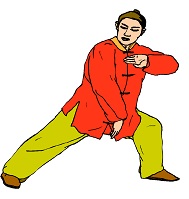Martial Arts - Belts
Among practitioners of the various martial arts, the various colors of your belt tells others how much you know about your specific martial art form and roughly where your skill level lies.
If you are looking for the information on the following:
 Many martial arts practices will use a colored belt to signify your rank and skill level within your particular style of martial arts.
Many martial arts practices will use a colored belt to signify your rank and skill level within your particular style of martial arts. Belts of various colors are used by many of the martial arts schools to signify rank within that particular style, although they have no universal meaning or ranking within the martial arts world overall. To the knowledgeable viewer, however, they tell others how much you know about your specific martial art training and skills. Although we tend to think of the use of belt colors in martial arts as "modern", the custom actually dates back hundreds of years. The use of belts in martial arts is generally conceded to have been started by a man known as Kanō Jigorō (1860-1938), a Japanese educator and athlete, who created the style known as Kodokan Judo. In the beginning, Kano used only white and black belts to signify rank within his style of martial arts. His original reason for using belts was to indicate which students could compete in different activities and competitions. At its most basic, those with white belts could not compete in the same activities as those with black belts. Shortly after Kanō Jigorō had introduced his idea of using belts to indicate levels of martial arts competence, belts of other colors were introduced to the world of martial arts. Over the following years, this became an accepted method of telling what experience and skill a student had achieved in his or her chosen style - just by belt color. Over time, many styles of close combat, including Karate, Tae Kwon Do, and other martial arts forms, began to use this system as well. One problem with using belts to signify ranking is the fact that currently each school of self defense often has different requirements for achievement from other schools. Even though they both may teach essentially the same style of martial arts, ranking systems and requirements to get a particular ranking, may be substantially different from one another. These differences can cause confusion among practitioners themselves, and interested observers as well, especially if a holder of a black belt from one school isn't as versed in his or her martial art style as the holder of a black belt from another school. Even though most schools seem to stick fairly close to the same criteria, there are schools that choose to make use of their own unique style as well.  Even though most martial arts styles use some sort of system of belts to signify rank, there are some martial arts, such as Shootfighting, which don't use belts at all. Even though most martial arts styles use some sort of system of belts to signify rank, there are some martial arts, such as Shootfighting, which don't use belts at all.The styles that choose not to use belts commonly don't make use of other rankings either, as they are more or less for self defense purposes. Pitfighting is another style that does not use belts either, nor do most schools which teach street fighting techniques. These styles are great to learn for self defense - although they differ from what are considered to be the traditional martial arts. To summarize, belts are a method that many martial arts use to give students a goal to aim for, and a reason to keep practicing. Most students that study martial arts seriously will aim for the highest level, most hoping to earn a black belt, which is commonly the most prestigious belt in martial arts practices. A black belt normally takes years of practice to obtain, and the student must move through many lower ranks of belts before getting the opportunity to try and earn the covetous black belt. 
|
Martial Arts - Belts For Skill and Experience - Copyright 2024 by Donovan Baldwin
Page Updated 10:53 AM Thursday, August 8, 2024

